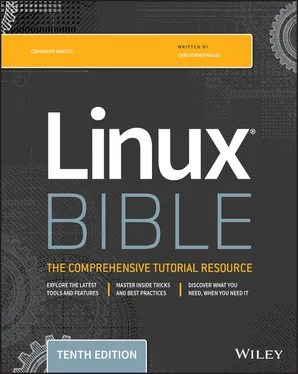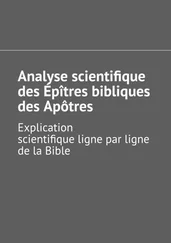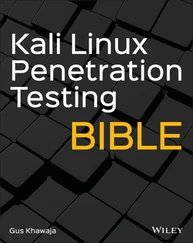1 Cover
2 Introduction How This Book Is Organized Conventions Used in This Book Jumping into Linux How to Contact Wiley or the Author
3 Part I: Getting Started CHAPTER 1: Starting with Linux Understanding What Linux Is Understanding How Linux Differs from Other Operating Systems Exploring Linux History Understanding How Linux Distributions Emerged Finding Professional Opportunities with Linux Today Summary CHAPTER 2: Creating the Perfect Linux Desktop Understanding Linux Desktop Technology Starting with the Fedora GNOME Desktop Live image Using the GNOME 3 Desktop Using the GNOME 2 Desktop Summary Exercises
4 Part II: Becoming a Linux Power User CHAPTER 3: Using the Shell About Shells and Terminal Windows Choosing Your Shell Running Commands Recalling Commands Using Command History Connecting and Expanding Commands Using Shell Variables Creating Your Shell Environment Getting Information about Commands Summary Exercises CHAPTER 4: Moving Around the Filesystem Using Basic Filesystem Commands Using Metacharacters and Operators Listing Files and Directories Understanding File Permissions and Ownership Moving, Copying, and Removing Files Summary Exercises CHAPTER 5: Working with Text Files Editing Files with vim and vi Finding Files Summary Exercises CHAPTER 6: Managing Running Processes Understanding Processes Listing Processes Managing Background and Foreground Processes Killing and Renicing Processes Limiting Processes with cgroups Summary Exercises CHAPTER 7: Writing Simple Shell Scripts Understanding Shell Scripts Summary Exercises
5 Part III: Becoming a Linux System Administrator CHAPTER 8: Learning System Administration Understanding System Administration Using Graphical Administration Tools Using the root User Account Exploring Administrative Commands, Configuration Files, and Log Files Using Other Administrative Accounts Checking and Configuring Hardware Summary Exercises CHAPTER 9: Installing Linux Choosing a Computer Installing Fedora from Live Media Installing Red Hat Enterprise Linux from Installation Media Understanding Cloud-Based Installations Installing Linux in the Enterprise Exploring Common Installation Topics Summary Exercises CHAPTER 10: Getting and Managing Software Managing Software on the Desktop Going Beyond the Software Window Understanding Linux RPM and DEB Software Packaging Managing RPM Packages with YUM Installing, Querying, and Verifying Software with the rpm Command Managing Software in the Enterprise Summary Exercises CHAPTER 11: Managing User Accounts Creating User Accounts Understanding Group Accounts Managing Users in the Enterprise Centralizing User Accounts Summary Exercises CHAPTER 12: Managing Disks and Filesystems Understanding Disk Storage Partitioning Hard Disks Using Logical Volume Manager Partitions Mounting Filesystems Using the mkfs Command to Create a Filesystem Managing Storage with Cockpit Summary Exercises
6 Part IV: Becoming a Linux Server Administrator CHAPTER 13: Understanding Server Administration Starting with Server Administration Checking and Setting Servers Managing Remote Access with the Secure Shell Service Configuring System Logging Checking System Resources with sar Checking System Space Managing Servers in the Enterprise Summary Exercises CHAPTER 14: Administering Networking Configuring Networking for Desktops Configuring Networking from the Command Line Configuring Networking in the Enterprise Summary Exercises CHAPTER 15: Starting and Stopping Services Understanding the Initialization Daemon (init or systemd) Checking the Status of Services Stopping and Starting Services Enabling Persistent Services Configuring a Default Runlevel or Target Unit Adding New or Customized Services Summary Exercises CHAPTER 16: Configuring a Print Server Common UNIX Printing System Setting Up Printers Working with CUPS Printing Using Printing Commands Configuring Print Servers Summary Exercises CHAPTER 17: Configuring a Web Server Understanding the Apache Web Server Getting and Installing Your Web Server Starting Apache Troubleshooting Your Web Server Summary Exercises CHAPTER 18: Configuring an FTP Server Understanding FTP Installing the vsftpd FTP Server Starting the vsftpd Service Securing Your FTP Server Configuring Your FTP Server Using FTP Clients to Connect to Your Server Summary Exercises CHAPTER 19: Configuring a Windows File Sharing (Samba) Server Understanding Samba Installing Samba Starting and Stopping Samba Securing Samba Configuring Samba Accessing Samba Shares Using Samba in the Enterprise Summary Exercises CHAPTER 20: Configuring an NFS File Server Installing an NFS Server Starting the NFS service Sharing NFS Filesystems Securing Your NFS Server Using NFS Filesystems Unmounting NFS filesystems Summary Exercises CHAPTER 21: Troubleshooting Linux Boot-Up Troubleshooting Troubleshooting Software Packages Troubleshooting Networking Troubleshooting Memory Troubleshooting in Rescue Mode Summary Exercises
7 Part V: Learning Linux Security Techniques CHAPTER 22: Understanding Basic Linux Security Implementing Physical Security Monitoring Your Systems Auditing and Reviewing Linux Summary Exercises CHAPTER 23: Understanding Advanced Linux Security Implementing Linux Security with Cryptography Implementing Linux Security with PAM Summary Exercises CHAPTER 24: Enhancing Linux Security with SELinux Understanding SELinux Benefits Understanding How SELinux Works Configuring SELinux Monitoring and Troubleshooting SELinux Putting It All Together Obtaining More Information on SELinux Summary Exercises CHAPTER 25: Securing Linux on a Network Auditing Network Services Working with Firewalls Summary Exercises
8 Part VI: Engaging with Cloud Computing CHAPTER 26: Shifting to Clouds and Containers Understanding Linux Containers Starting with Linux Containers Summary Exercises CHAPTER 27: Using Linux for Cloud Computing Overview of Linux and Cloud Computing Trying Basic Cloud Technology Setting Up a Small Cloud Summary Exercises CHAPTER 28: Deploying Linux to the Cloud Getting Linux to Run in a Cloud Creating Linux Images for Clouds Using OpenStack to Deploy Cloud Images Using Amazon EC2 to Deploy Cloud Images Summary Exercises CHAPTER 29: Automating Apps and Infrastructure with Ansible Understanding Ansible Exploring Ansible Components Stepping Through an Ansible Deployment Installing Ansible Running Ad-Hoc Ansible Commands Automating Tasks with Ansible Tower Automation Framework Summary Exercises CHAPTER 30: Deploying Applications as Containers with Kubernetes Understanding Kubernetes Trying Kubernetes Enterprise-Quality Kubernetes with OpenShift Summary Exercises
9 Part VII: Appendixes APPENDIX A: MediaMedia Getting Fedora Getting Red Hat Enterprise Linux Getting Ubuntu Booting Linux from a USB Drive Creating Linux CDs and DVDs APPENDIX B: Exercise AnswersExercise Answers Chapter 1: Starting with Linux Chapter 2: Creating the Perfect Linux Desktop Chapter 3: Using the Shell Chapter 4: Moving Around the Filesystem Chapter 5: Working with Text Files Chapter 6: Managing Running Processes Chapter 7: Writing Simple Shell Scripts Chapter 8: Learning System Administration Chapter 9: Installing Linux Chapter 10: Getting and Managing Software Chapter 11: Managing User Accounts Chapter 12: Managing Disks and Filesystems Chapter 13: Understanding Server Administration Chapter 14: Administering Networking Chapter 15: Starting and Stopping Services Chapter 16: Configuring a Print Server Chapter 17: Configuring a Web Server Chapter 18: Configuring an FTP Server Chapter 19: Configuring a Windows File Sharing (Samba) Server Chapter 20: Configuring an NFS File Server Chapter 21: Troubleshooting Linux Chapter 22: Understanding Basic Linux Security Chapter 23: Understanding Advanced Linux Security Chapter 24: Enhancing Linux Security with SELinux Chapter 25: Securing Linux on a Network Chapter 26: Shifting to Clouds and Containers Chapter 27: Using Linux for Cloud Computing Chapter 28: Deploying Linux to the Cloud Chapter 29: Automating Apps and Infrastructure with Ansible Chapter 30: Deploying Applications as Containers with Kubernetes
Читать дальше












